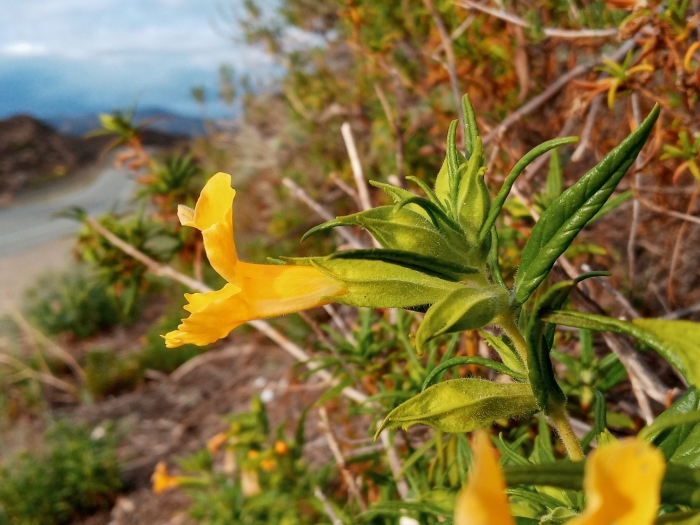Southern Bush Monkeyflower
(Diplacus longiflorus)
Southern Bush Monkeyflower (Diplacus longiflorus)
/
/

Daniel S.
CC BY 4.0
Image By:
Daniel S.
Recorded By:
Copyright:
CC BY 4.0
Copyright Notice:
Photo by: Daniel S. | License Type: CC BY 4.0 | License URL: http://creativecommons.org/licenses/by/4.0/ | Rights Holder: Daniel S. | Publisher: iNaturalist | Date Created: 2021-04-26T18:03:39-07:00 |


















































Estimated Native Range
Summary
Diplacus longiflorus, commonly known as Southern Bush Monkeyflower, is a semi-deciduous subshrub native to the coastal sage scrub and chaparral of California, as well as the northern regions of Baja California in Mexico. This plant typically grows to a height and width of 1-3 feet (0.3-0.9 meters), featuring narrow, lance-shaped leaves and a bushy growth habit. The Southern Bush Monkeyflower is particularly noted for its tubular, yellow to orange flowers that bloom profusely in the spring and summer, attracting hummingbirds and other pollinators.
In the garden, Diplacus longiflorus is valued for its drought tolerance and vibrant floral display, making it a suitable choice for xeriscaping, native plant gardens, and wildlife habitats. It thrives in full sun to part shade and prefers well-drained soils, although it can tolerate a range of soil types. This plant is relatively low-maintenance, requiring minimal water once established. While it is not commonly afflicted by serious diseases or pests, overwatering can lead to root rot. It can be propagated easily from cuttings and is often used in restoration projects due to its ecological benefits.CC BY-SA 4.0
In the garden, Diplacus longiflorus is valued for its drought tolerance and vibrant floral display, making it a suitable choice for xeriscaping, native plant gardens, and wildlife habitats. It thrives in full sun to part shade and prefers well-drained soils, although it can tolerate a range of soil types. This plant is relatively low-maintenance, requiring minimal water once established. While it is not commonly afflicted by serious diseases or pests, overwatering can lead to root rot. It can be propagated easily from cuttings and is often used in restoration projects due to its ecological benefits.CC BY-SA 4.0
Plant Description
- Plant Type: Subshrub, Shrub
- Height: 1-3 feet
- Width: 1-3 feet
- Growth Rate: Moderate
- Flower Color: Yellow
- Flowering Season: Spring, Summer
- Leaf Retention: Semi-Deciduous
Growth Requirements
- Sun: Full Sun, Part Shade
- Water: Low
- Drainage: Medium, Fast
Common Uses
Bee Garden, Bird Garden, Butterfly Garden, Deer Resistant, Drought Tolerant, Erosion Control, Fire Resistant, Groundcover, Hummingbird Garden, Low Maintenance, Showy Flowers
Natural Habitat
Coastal sage scrub and chaparral of California, and northern Baja California
Other Names
Common Names:
Scientific Names: , Diplacus longiflorus, Mimulus longiflorus, Mimulus longiflorus var. longiflorus, Mimulus longiflorus subsp. longiflorus, Mimulus glutinosus var. brachypus, Diplacus arachnoideus, Diplacus speciosus, Diplacus aurantiacus var. longiflorus, Mimulus glutinosus subsp. brachypus,
GBIF Accepted Name: Diplacus longiflorus Nutt.